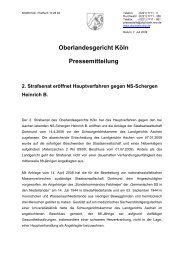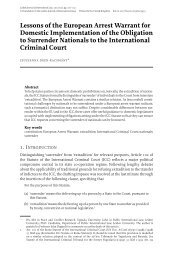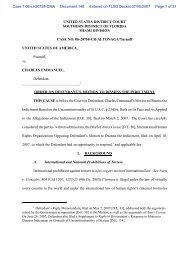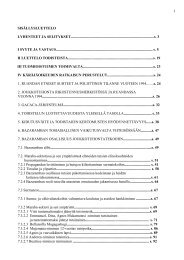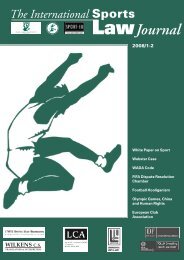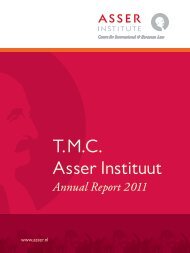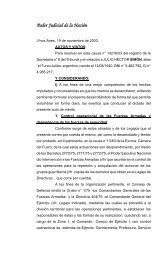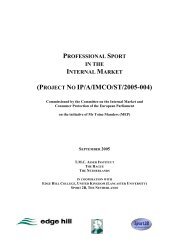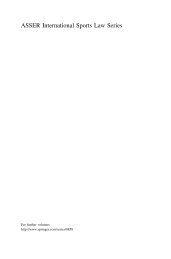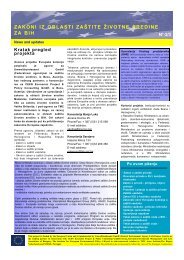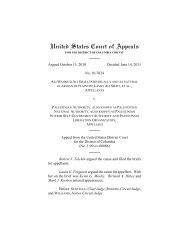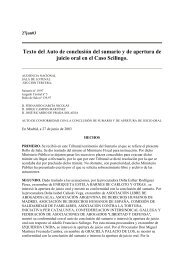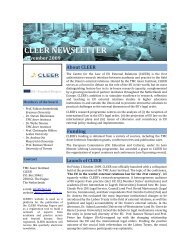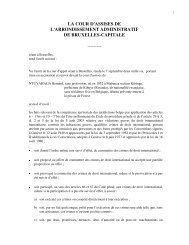Islj 2009 3-4 - TMC Asser Instituut
Islj 2009 3-4 - TMC Asser Instituut
Islj 2009 3-4 - TMC Asser Instituut
Create successful ePaper yourself
Turn your PDF publications into a flip-book with our unique Google optimized e-Paper software.
to the amount of regulations in the field of sport that result from their<br />
own legislation: on the one hand, there are states with a liberal model<br />
of interference in the field of sport and on the other hand, states<br />
which use an interventionist model. The interventionist model,<br />
which he considers to be dominant in the Slovak Republic, is characterized<br />
by a situation where the state is the main sponsor of sport,<br />
usually through government institutions. The state in this model is<br />
also responsible for the development and support of sport and cooperates<br />
with sports organizations. 1<br />
Although the abovementioned Act no. 288/1997 is not particularly<br />
voluminous and does not have a complex character, it does indeed<br />
still contain the elements of state intervention in the field of sports.<br />
The Act lists the public bodies in charge of physical culture and<br />
defines their competence. One of the tasks so defined by this Act is to<br />
support the preparation and participation of athletes in representing<br />
the Slovak Republic. Certain public bodies are obliged to co-operate<br />
to secure the conditions and facilities necessary for the preparation of<br />
athletes and their medical care, as well as the exemption of athletes<br />
from military service. In particular, the Act determines the amount of<br />
financial support allocated to sport from the annual state budget, of<br />
which a minimum of 0,5 % is to be spent on physical education. It<br />
also includes the resources from the national budget determined by<br />
the special Act on state support of sport.<br />
The Act on physical culture provided for the adoption of the Act<br />
on state support of sport. The legislator realized however that in practice,<br />
sport includes many more issues than just state support of sport<br />
and faced the more demanding task of creating a Sports Act which<br />
would comprehensively regulate all the legal relationships that stem<br />
from involvement in sport activities.<br />
3. Original proposal of the Sport Act<br />
It has been claimed that especially the professionalization of sport<br />
brought with it a plethora of ambiguities, legislative gaps, and other<br />
problems and questions which resonate throughout the entire legal<br />
system. 2 Many of these problems were determined by the decisions of<br />
the EĆJ in the cases mentioned above which mainly concerned the<br />
legal position of professional athletes in team sports and individual<br />
sports, the legal nature of contractual relations between professional<br />
athletes and sport clubs, the status and degree of autonomy of sport<br />
organizations, the question of broadcasting concessions for sport<br />
events, sponsorship, etc.<br />
In the previous electoral term, the Government of the Slovak<br />
Republic already prepared a bold and ground-breaking proposal for a<br />
Sport Act, 3 in which solutions for many of these problems were determined.<br />
The proposal was bold in that it would quite radically change<br />
the position of athletes and their relationship to sport clubs.<br />
The proposal started from two distinctions that can be made within<br />
sport that influence the position of athletes, namely the distinction<br />
between amateur and professional sports and the distinction between<br />
team and individual sports. Although the legislator hereby chose the<br />
correct approach, it did not, in my opinion, reach the aspired goal, as<br />
the criteria used to make the distinctions were unsuitable.<br />
3.1. Professional and amateur sport<br />
Article 2(2)(b) of the proposal defined a professional athlete as a person<br />
who performs sport as part of an employment relationship based<br />
on a sport contract or on a freelance basis, while Article 2(2)(c) defined<br />
an amateur athlete as a person who performs sport on the basis of a<br />
contract for the performance of sport activities.<br />
However, this latter definition of amateur athlete did not match the<br />
general idea of what was considered the essence of amateur sport as it<br />
contradicts the present understanding of amateur sport as an activity<br />
1 Králík, M.: Právo ve sportu. Praha: C.<br />
H. Beck, 2001, s. 179.<br />
2 Králík, M.: Zamyšlení nad tzv.<br />
sportovním právem. Právní rozhledy, vi,<br />
1998, c. 10, s. 491.<br />
3 The full wording of this Act can be<br />
found at www.rokovania.sk/appl/<br />
material.nsf/0/FE52238C945CF595C1257<br />
1060048FC41/$FILE/Zdroj.html (d’alej<br />
len “návrh zákona o športe”).<br />
4 Sobczak, J.: Prawo sportowe (wybór<br />
aktów normatywnych), Toruń:<br />
Towarzystwo Naukowe Organizacji i<br />
Kierownictwa, 1998, s. 16.<br />
performed without any financial reward. For example, Article 1.29(11)<br />
of the Rules of transfer of amateur footballers, which were adopted by<br />
the Slovak Football Association on 10 July 1993, defines an amateur<br />
(in accordance with the FIFA provisions for the status and transfer of<br />
players) as a player who has never received a financial reward for their<br />
football performance above the amount of real expense following<br />
from their performance.<br />
Similarly, the Polish Act on physical culture perceives the receipt of<br />
a financial reward for the performance of sport as the criterion distinguishing<br />
professional sport from amateur sport. It further also states<br />
in Article 3 that professional sport is performed for the purpose of a<br />
financial reward. 4<br />
There are of course cases where amateur athletes receive a certain<br />
reward for performing a sport activity, but generally this is restricted<br />
to a reward intended to compensate them for any expenses resulting<br />
from taking part in the competition. However, such a reward must<br />
not constitute a reward for their actual participation in a sport competition.<br />
Payment of compensation for the expenses of amateur athletes is<br />
based on the legal relationship between the sports club or association<br />
and the athlete who is a member of this club or association. It is not<br />
based on a service contract other than an employment contract as this<br />
would mean that the athlete should be granted a reward in addition<br />
to compensation of expenses.<br />
3.2. Team and individual sport<br />
The proposal for the Sports Act contained two ways in which to<br />
define professional athletes, namely professional athletes who perform<br />
their activity on the basis of a sport contract and professional athletes<br />
who perform their activity on a freelance basis. The main difference is<br />
whether the athlete performs a team sport or an individual sport. If<br />
they perform a team sport, they act on behalf of a club to which they<br />
are tied by means of a sports contract, while in the case of an individual<br />
sport the athlete performs the sport independently.<br />
Article 1(2)(c) of the proposal defines a team sport as a branch of<br />
sport that is performed by at least two persons who act as one participant<br />
in a sport competition, provided there is no competition of<br />
individuals in this competition.<br />
The proposal offers no definition of individual sport, which may be<br />
presumed to mean that all other sports are considered individual<br />
sports.<br />
The phrase ‘provided there is no competition of individuals in this<br />
competition’ may give rise to certain problems. If the legislator<br />
intended it to mean that collective sports are only those which exclusively<br />
include competitions of teams and do not include competitions<br />
of individuals, a problem may arise in the classification of certain<br />
sports, such as for example tennis, boxing, swimming and athletics,<br />
which may include both team competitions and individual competitions.<br />
At the same time, if athletes compete on behalf of a sports club,<br />
their performance in these sports should be considered according to<br />
the rules applying to team sports given that they have entered into a<br />
relationship with the sports club which contains the same elements as<br />
in a ‘purely’ team sport. However, this interpretation would be more<br />
acceptable if the definition contained the wording ‘provided there is<br />
no competition of individuals in this sport’.<br />
However, the legislator chose to use the words ‘provided there is no<br />
competition of individuals in this competition’ by which it probably<br />
meant ‘competition of teams’. In this sense, some branches of sport<br />
where both teams and individuals take part in competition should<br />
then be considered to be both individual and team sports.<br />
A problem with interpretation could emerge for example in cases<br />
such as the Formula 1 competition, where two kinds of evaluation<br />
exist within one and the same competition - the award for individual<br />
pilots and the award for teams (Constructors’ Championship). This<br />
would imply that car racing, or at least Formula1, is an individual<br />
sport, although the relationship between individual Formula 1 pilots<br />
and their teams is evidently built on principles that are similar to the<br />
principles at work in the relationship between athletes and sports club<br />
in team sports.<br />
66 <strong>2009</strong>/3-4<br />
A RT I C L E S



